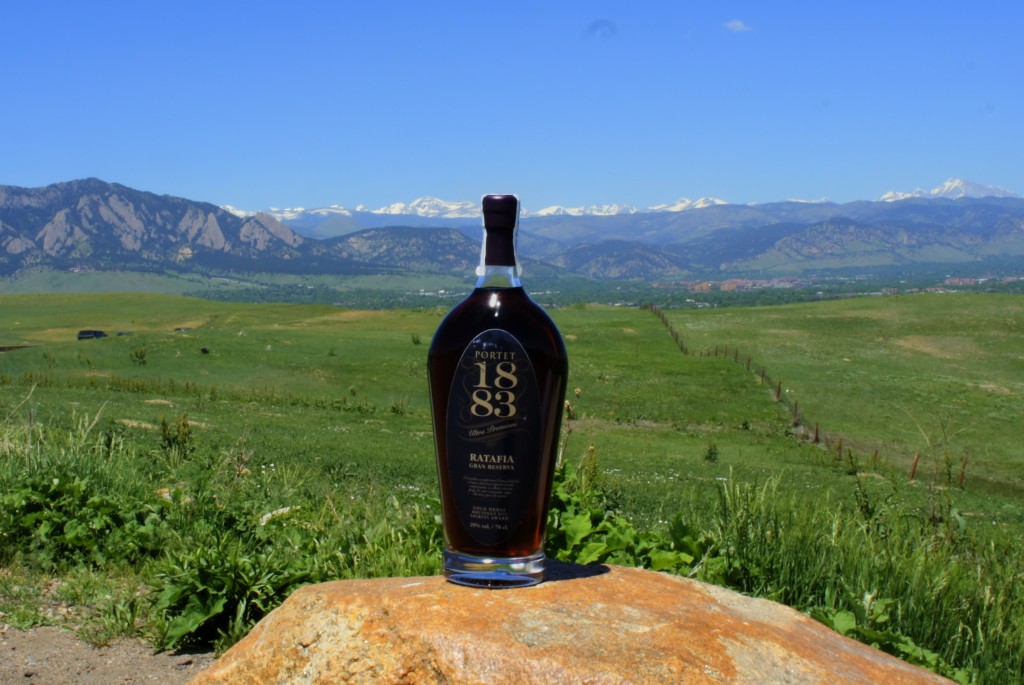Ah, Ratafia!
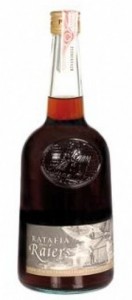 I had never heard of Ratafia until I visited Pobla de Segur, a town of 3,000 in the foothills of the Pyrenees. Mere chance led me to a non-descript building at number 4, Avenida Sant Miquel del Pui, just a half a block from the town’s church. This was “Portet Distributions”. Over the front door, bold red letters on a retracted tan awning declared it to be a “Maker of traditional liqueurs of the Pyrenees”.
I had never heard of Ratafia until I visited Pobla de Segur, a town of 3,000 in the foothills of the Pyrenees. Mere chance led me to a non-descript building at number 4, Avenida Sant Miquel del Pui, just a half a block from the town’s church. This was “Portet Distributions”. Over the front door, bold red letters on a retracted tan awning declared it to be a “Maker of traditional liqueurs of the Pyrenees”.
The retail shop was just inside the front door, the room full of an assortment of bottles filled with colorful liquids. There were tall tapered bottles, small gift bottles, bottles of ornately embellished glass, and a whole row of bottles whose glass neck included a relief image of a man on a raft. I asked for more information, and about 15 minutes later a solidly built bearded man in a dark plaid shirt arrived. His name was Àngel Portet. He and his brother Carlos own the distillery. Over the next forty minutes he gave me a tour of the site, as well as an education about the history and traditions associated with Ratafia.
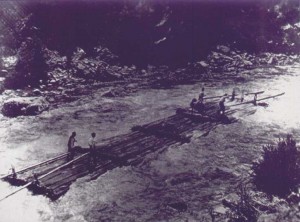
The name of this business’s signature offering, “Ratafia dels Raiers”, pays tribute to the “Raiers” (rafters), who worked as part of the lumbering process. This now defunct occupation involved tying great logs together into rafts, and floating them down the Noguera Pallaresa river to the Segre and onward toward Lleida.
Ratafia is the classic liqueur of Catalunya. For generations it has been made in the small towns and on farmsteads throughout the foothills and mountain areas of the Pyrenees. In some areas of France, the term Ratafia can refer to a sort of sangria (wine mixed with fruit juice) embellished with cinnamon or other flavorings. But the classic Ratafia of Catalunya is a smooth sweet liqueur created from a base of aguardiente or anisette, to which the distilled essence of herbs is added.
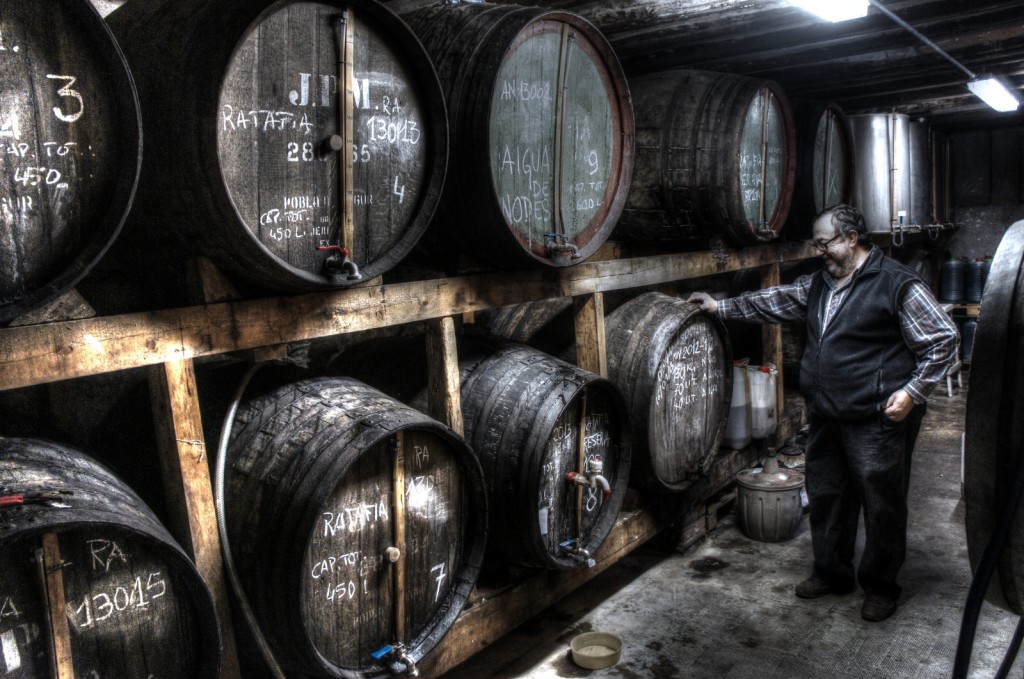
Àngel and I hit it off right away, and he went into great detail about the origins of this small family business, founded in 1883. A room between the retail shop and the distillery itself was adorned with old photos, and with various copper and clay vessels and other paraphernalia that had once been in active use in the distillery. On one wall, a long bent copper pipe, discolored with age, formed an arc over an antique photo of a group of workers posing next to a large keg. By their style of dress, it must have been the early 1900s. Àngel pointed out that the very same copper pipe mounted on the wall appeared in the photo.
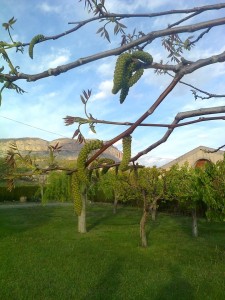
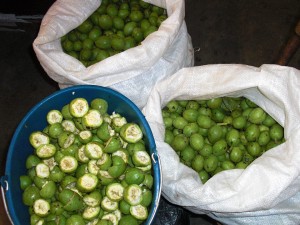
Walnuts, as well as over a dozen different aromatic herbs contribute to the blend that gives Ratafia its distinctive flavor. Tradition calls for the walnuts used in Ratafia to be harvested on the feast of Sant Joan (St. John / San Juan), which aligns with the summer solstice- the longest day of the year. At this point, the nuts are mature but still soft enough to be sliced with a knife.
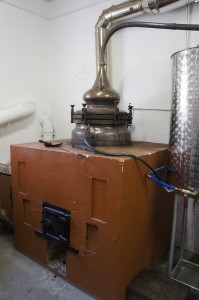 Àngel took me to a room where distillation was in progress. A cube shaped cement block encased a double-envelope tank with a small wood burning firebox inset below. This was the still. He explained that the temperature must be carefully controlled and that a gas burner would be easier than the wood fire, but… and here he shrugged his shoulders. Tradition is paramount at the Portet distillery. The exposed cap of the distilling chamber had the graceful shape of an onion, and its metal surface revealed subtle discolorations indicative of both the heat and its age.
Àngel took me to a room where distillation was in progress. A cube shaped cement block encased a double-envelope tank with a small wood burning firebox inset below. This was the still. He explained that the temperature must be carefully controlled and that a gas burner would be easier than the wood fire, but… and here he shrugged his shoulders. Tradition is paramount at the Portet distillery. The exposed cap of the distilling chamber had the graceful shape of an onion, and its metal surface revealed subtle discolorations indicative of both the heat and its age.
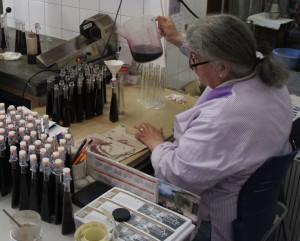 In another room two women in smocks were seated at tables, carefully measuring Ratafia into small but distinctively shaped gift-sized bottles. A stack of labels lay on one end of a table, ready to be affixed to the bottles.
In another room two women in smocks were seated at tables, carefully measuring Ratafia into small but distinctively shaped gift-sized bottles. A stack of labels lay on one end of a table, ready to be affixed to the bottles.
Every aspect of the processes here was touched by careful craftsmanship- human effort, not mechanized automation.
Àngel spoke about his struggles with the supply of bottles the company uses for its liqueurs. These include a wide range of sizes and shapes, and of course the bottles with the image of the “raier”. Quality was a requisite, and depending on the country of origin, the price could fluctuate with currency exchange rates. But the biggest challenge is that this is a small company, so the quantity of bottles he purchases is miniscule compared with most enterprises. He told me how conversations with bottle vendors went: “Oh, that is all you need to buy? Poor man. Why don’t you buy a whole trailer-load of bottles, then we can talk!”
Besides Ratafia, the Portet distillery produces a variety of sweet liqueurs from various berries, including raspberries, strawberries, gooseberries, cranberries, black current, and blackthorn.
Although their core production involves spirits that are rooted in tradition, Àngel and his brother experiment with new creations, including a rather unique liqueur flavored with the essence of mushrooms!
I was content as I left this small, family run distillery. I felt as if here in the foothills of the Pyrenees, I had stumbled into a secret room piled with gold and jewels.
Epilogue:
Late the next morning, it was time to head back to the city of Lleida, and then to Barcelona. I packed up my suitcase, and checked out of Can Fasersia, the boarding house where I was staying, and began my walk to the train station. As I crossed the bridge over the Flamisell River, I heard the toot of a horn. I turned my head and saw Àngel at the wheel of a small van passing by. He greeted me with a wave of his hand and continued down the road. What better send-off from this little town could I have had?
